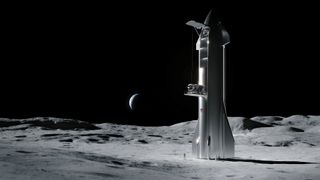

If you're thinking about booking a trip on SpaceX's huge Starship spacecraft, the company has some reading material for you.
SpaceX just released a users' guide for Starship, the reusable spaceship-rocket combo the company is developing to help colonize Mars. As the guide makes clear, Starship is designed to be a flexible transportation system, one capable of delivering both people and payloads to a variety of off-Earth destinations.
Indeed, the company will develop cargo and crewed variants of Starship. The cargo version will be capable of hauling gear quickly from point to point around Earth in addition to its space duties, according to the guide, which is the first version of a document that SpaceX said will be updated frequently.
The crew version will be able to accommodate up to 100 passengers, who will travel in style. From the guide: "The crew configuration of Starship includes private cabins, large common areas, centralized storage, solar storm shelters and a viewing gallery."
The guide lays out some specifications, including details about payload capacity (100 metric tons to low Earth orbit for the baseline design), launch and landing. (SpaceX is planning two Starship launch sites initially: NASA's Kennedy Space Center in Florida and the company's South Texas facilities, near the village of Boca Chica.)


Prices are not given, however. SpaceX is generally quite open about its launch pricing, so perhaps the company has not yet worked out how much a Starship ride will cost.
Customers will start using the new guide in earnest soon, if all goes according to SpaceX's plan. Starship could start flying operational missions next year, company representatives have said.
Those first flights will likely loft communications satellites to Earth orbit. But SpaceX does have one crewed mission on Starship's manifest. Japanese billionaire Yusaku Maezawa booked the craft for a round-the-moon mission, with a target launch date of 2023.
There's a lot of work to do before such missions can lift off, however; SpaceX is still developing and testing Starship prototypes. The company is currently working on the prototype SN3 (Serial No. 3), which is poised to start undergoing testing at Boca Chica soon.
SN3 will eventually fly short test missions in Earth's atmosphere, SpaceX founder and CEO Elon Musk has said. Musk wants the craft's successor, SN4, to fly even higher — up to about 12 miles (20 kilometers) above Earth's surface.